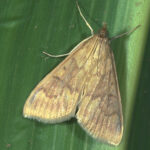
ECB Adult Flight Begins This Week
European corn borer: We observed our first trap captures of the adult European corn borer on the 2nd of May in New Paltz, NY. Populations will likely continue to climb with scouting to begin in newly planted trees beginning by the weekend. Female ECB moths will begin laying egg masses on the underside of apple leaves and larval feeding, if ECB is present, should become evident in newly developing apple shoots within the next two weeks. It is likely that fruit trees with ECB injury will have higher damage levels along the perimeter and where tall broad leaf weeds are present. The Eastern strain of European corn borer has a wide host range, attacking robust herbaceous plants with a stem large enough for the larvae to enter. Some of the common weeds infested include barnyardgrass, Echinochoa crus-galli; beggarticks, Bidens spp.; cocklebur, Xanthium spp.; dock, Rumex spp.; jimsonweed, Datura spp.; panic grass, Panicum spp.; pigweed, Amaranthus spp.; smartweed, Polygonum spp.; and others.
There are reports that weather influences European corn borer survival. Heavy precipitation during egg hatch is sometimes an important mortality factor. Low humidity, low nighttime temperatures, and heavy rain and wind are detrimental to moth survival and oviposition. However, like most insect pests, they seem to thrive during unlikely weather scenarios in years past.

ECB larva on apple

ECB Frass, Infestation of Young Apple
Typical examples of ECB feeding on apple is similar to that of Oriental Fruit Moth on apple with frass and entry under petiole or side shoot of new shoots.
Delegate 25WG is labeled and very effective against ECB on newly planted trees.

Temp. Effect on ECB Efficacy (Tony Shelton, NYSAES)

ECB in Gala fruit, July 2004

ECB in apple fruit, July 2004

Efficacy of pyrethroids on ECB







